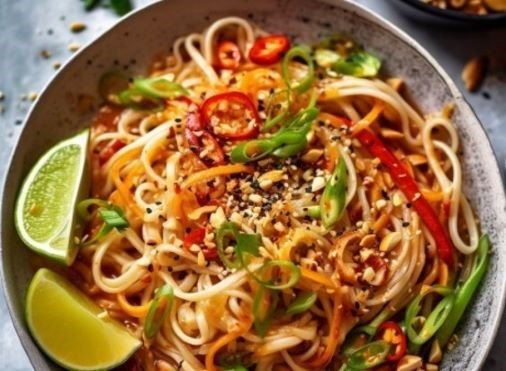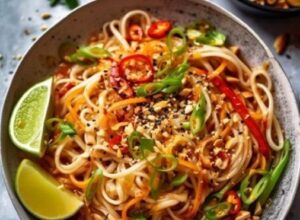Pad Thai Recipe
I still remember that vibrant Bangkok street, brimming with colorful stalls and the intoxicating aroma of various delicacies being cooked to perfection. It was there, amidst the hustle and bustle, that I first tasted Pad Thai. The medley of flavors – tangy, sweet, and savory – danced on my palate, and the textures of soft noodles contrasted with crunchy peanuts sealed the deal. As a housewife with a penchant for cooking and critiquing food, I knew I had to recreate this dish at home, adding my own twist to it.
What is Pad Thai
Pad Thai, or Phad Thai, is arguably one of the most iconic dishes from Thailand. It’s a tantalizing stir-fry noodle dish, typically made with rice noodles sautéed in a sizzling wok along with a medley of ingredients. These can include shrimp, tofu, or chicken, and are often combined with bean sprouts, garlic, onions, and eggs. A symphony of flavors emerges from the signature Pad Thai sauce – a blend of tamarind pulp, fish sauce, chili, and sugar. Garnished with crushed peanuts, fresh lime, and cilantro, the dish is a vivid representation of the essence of Thai cuisine – a harmonious balance of flavors and textures.
Recreating this dish at home has allowed me not only to relive those moments on that bustling Bangkok street but also to appreciate the intricacies of Thai culinary traditions. So, next time you’re looking for a dish that’s both comforting and bursting with flavor, let the art of making Pad Thai guide you. With its rich tapestry of flavors and textures, it encapsulates the spirit of Thai cuisine. And while the traditional recipe holds its own charm, the variations make it adaptable to different palates and preferences.
Variations of Pad Thai
The beauty of Pad Thai lies in its versatility. Here are a few twists to this classic dish:
- Protein Variations: While shrimp and chicken are popular choices, you can also try beef or even tempeh for a vegetarian spin.
- Vegetable Infusion: Incorporate colorful bell peppers, snap peas, or even broccoli to add a nutritious punch and a burst of colors.
- Spice it Up: For those who crave a fiery kick, adding Thai red curry paste or extra red chili flakes can elevate the dish’s heat quotient.
- Noodle Alternatives: Though rice noodles are the traditional choice, experimenting with soba noodles or even spaghetti can lend a unique texture and flavor to the dish.
Nutrition – Pad Thai
Beyond its captivating flavors, Pad Thai also offers a bouquet of health benefits:
- Protein Source: Whether you choose shrimp, chicken, or tofu, Pad Thai can be a substantial source of protein, essential for muscle building and repair.
- Vitamins and Minerals: The addition of bean sprouts, tofu, and shrimp ensures a dose of iron, calcium, and essential vitamins, promoting overall health.
- Healthy Carbs: Rice noodles, being gluten-free, provide energy without the heaviness associated with some wheat-based products.
- Antioxidants: Ingredients like garlic, onions, and tamarind not only enhance flavor but also infuse the dish with antioxidants, fostering immune health.
Step by Step Pad Thai Recipe

Pad Thai Recipe
Ingredients
- 8 oz thin rice noodles
- 8 oz protein of choice chicken, shrimp, tofu, or beef
- 2 cups Onions
- 2 cups capsicum / bell peppers
- 1 cup green onion / Scallions
- 3 cloves garlic minced
- 2 egg
- 2 tbsp Oil
- 2 tbsp soy sauce
- 2 tbsp fish sauce
- 2 tbsp brown sugar
- 1 tsp chilli flakes optional
- 1/4 cup peanuts
- 1/4 cup coriander leaves / cilantro
- 2 limes cut into wedges
Instructions
Pre-Cooking Prep Steps
- Soak the rice noodles in warm water for about 20 minutes or until they are soft and pliable. Drain and set aside.
- Slice the onions, bell peppers, and scallions and set aside.
- Mince the garlic and set aside.
- In a small bowl, mix together the soy sauce, fish sauce, brown sugar, and red pepper flakes (if using).
- Crack the eggs into a separate bowl and beat them lightly.
Cooking Steps
- Heat the oil in a large wok or skillet over high heat.
- Add the protein of choice and stir-fry for about 5-7 minutes, or until cooked through. Remove the protein from the pan and set aside.
- Add the onions, bell peppers, and scallions to the pan and stir-fry for about 2-3 minutes, or until slightly softened.
- Add the garlic and stir-fry for about 1 minute, or until fragrant.
- Push the vegetables to one side of the pan and pour the beaten eggs on the empty side. Cook until scrambled and then mix with the vegetables.
- Add the rice noodles to the pan, along with the sauce mixture. Use a pair of tongs to toss the ingredients together until the noodles are evenly coated with the sauce.
- Add the cooked protein back to the pan and toss to combine.
- Cook for an additional 1-2 minutes, or until the noodles are heated through and slightly crispy.
- Turn off the heat and garnish with chopped peanuts, cilantro, and lime wedges.

Equipment Used for This Recipe
- Wok or Kadai
- Tong
Notes & Tips
- Pad Thai can be made spicier by adding additional red pepper flakes or fresh chili peppers to the sauce mixture.
- For a gluten-free option, substitute soy sauce with tamari or coconut aminos.
- If you prefer a sweeter Pad Thai, you can add more brown sugar to the sauce mixture.
- Feel free to add other vegetables such as carrots, zucchini, or mushrooms to the dish for added nutrition and flavor.
- If you prefer a less oily dish, you can reduce the amount of oil used in the recipe.
Nutrition Information (Note: Approximate)
FAQs – Pad Thai Recipe
What is the origin of Pad Thai?
Pad Thai, an iconic dish of Thailand, has a rich history. While its exact origin is debated, it gained prominence during the 1930s and 1940s in Thailand due to rice shortages. It was an effort to promote a national dish that utilized abundant rice noodles. Since then, this stir-fry noodle dish has become a global sensation, marrying the quintessential Thai flavors and making it an integral part of Thai cuisine.
How does the flavor of Pad Thai differ from other Thai dishes?
Pad Thai offers a harmonious blend of sweet, sour, savory, and spicy flavors. Unlike some Thai curries which are predominantly spicy or coconut-based, Pad Thai is more about balance. The tamarind pulp lends a tangy touch, which, when combined with the sweetness of sugar and the saltiness of fish sauce, creates a captivating taste profile. If you’ve tried Indian dishes like “Pav Bhaji” that meld a variety of flavors, think of Pad Thai as its Thai counterpart in terms of complexity.
Can I make a vegetarian or vegan version of Pad Thai?
Absolutely! Pad Thai is incredibly versatile. For a vegetarian spin, you can use tofu as your primary protein and skip any fish or oyster sauces, opting for soy sauce instead. If you’re aiming for a vegan version, ensure that no eggs are added. The beauty of this dish, much like the flexibility of many Indian recipes, is that it can be tailored to fit dietary preferences without compromising on flavor.
Is there a gluten-free option for Pad Thai?
Yes, Pad Thai can easily be made gluten-free. The primary ingredient, rice noodles, is naturally gluten-free. However, ensure you check the labels of sauces, especially soy sauce, as some might contain gluten. Opt for a gluten-free soy sauce or tamari. Remember, just as in Indian cooking where we substitute wheat-based rotis with “jowar” or “bajra” rotis, adapting recipes to dietary needs is both possible and delicious.
How spicy is traditional Pad Thai?
Traditionally, Pad Thai offers a mild to moderate heat. However, the beauty of Thai (and much like Indian) cuisine lies in its adaptability. You can control the spiciness by adjusting the amount of red chili or chili flakes. If you’re someone who enjoys the fiery kick of dishes like “Vindaloo”, you can amp up the heat in your Pad Thai. Conversely, for a milder version, tone down or skip the chilies.
What are the primary health benefits of Pad Thai?
Pad Thai is nutritionally rich, offering a balanced mix of protein, healthy carbs, and essential vitamins. Depending on the ingredients used, you can benefit from iron, calcium, and antioxidants. For instance, shrimp brings in protein and essential minerals, while ingredients like garlic and tamarind offer antioxidants. It’s a dish that, when made thoughtfully, can be both tasty and nourishing, akin to well-prepared Indian meals.
Can I use alternative noodles for Pad Thai?
While rice noodles are traditional, Pad Thai is adaptable. You could experiment with soba noodles, spaghetti, or even “sevai” (Indian rice noodles). Each variation will bring a unique texture and flavor, making your Pad Thai experience novel each time.
How does Pad Thai compare to other noodle dishes?
Pad Thai stands out for its perfect blend of flavors and textures. Unlike some noodle dishes that lean heavily on a particular taste, Pad Thai aims for balance. If you’ve relished the layered flavors in Indian “Biryani”, you’d appreciate the depth and complexity in a well-made Pad Thai. It’s a dance of sweet, tangy, spicy, and savory, all on one plate.
Also See:
———————————————————————————————————
Foodcazt (www.foodcazt.com) is a Food Magazine. We help you discover food. Benefit from our Recipes, Reviews, Food Guides & Articles. We uncover trends, especially for Indian and Asian Cuisines. Please follow us to learn more. Uncover recipes. Learn about trends. Unearth unique restaurants. Find what moves you. Discover what inspires others. We uncover trends, especially for Indian Cuisine and Asian Cuisine. It would mean the world to us, if you follow, like or subscribe on: YouTube, Facebook, Twitter, Instagram.



